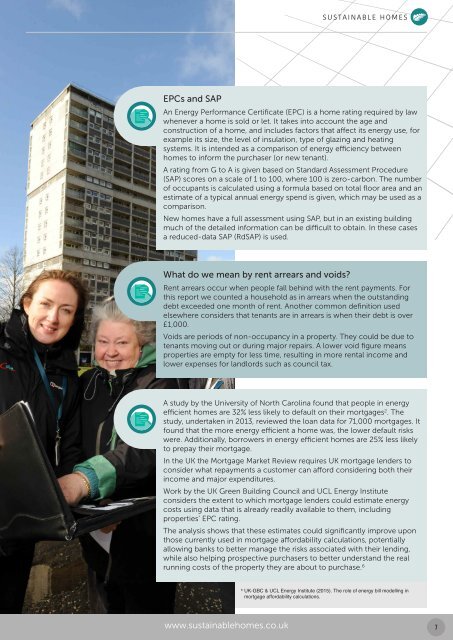voids
w7Fk302h3jh
w7Fk302h3jh
You also want an ePaper? Increase the reach of your titles
YUMPU automatically turns print PDFs into web optimized ePapers that Google loves.
SUSTAINABLE HOMES<br />
EPCs and SAP<br />
An energy Performance certificate (ePc) is a home rating required by law<br />
whenever a home is sold or let. it takes into account the age and<br />
construction of a home, and includes factors that affect its energy use, for<br />
example its size, the level of insulation, type of glazing and heating<br />
systems. it is intended as a comparison of energy efficiency between<br />
homes to inform the purchaser (or new tenant).<br />
A rating from g to A is given based on standard Assessment Procedure<br />
(sAP) scores on a scale of 1 to 100, where 100 is zero-carbon. The number<br />
of occupants is calculated using a formula based on total floor area and an<br />
estimate of a typical annual energy spend is given, which may be used as a<br />
comparison.<br />
new homes have a full assessment using sAP, but in an existing building<br />
much of the detailed information can be difficult to obtain. in these cases<br />
a reduced-data sAP (RdsAP) is used.<br />
What do we mean by rent arrears and <strong>voids</strong>?<br />
Rent arrears occur when people fall behind with the rent payments. For<br />
this report we counted a household as in arrears when the outstanding<br />
debt exceeded one month of rent. Another common definition used<br />
elsewhere considers that tenants are in arrears is when their debt is over<br />
£1,000.<br />
<strong>voids</strong> are periods of non-occupancy in a property. They could be due to<br />
tenants moving out or during major repairs. A lower void figure means<br />
properties are empty for less time, resulting in more rental income and<br />
lower expenses for landlords such as council tax.<br />
A study by the university of north carolina found that people in energy<br />
efficient homes are 32% less likely to default on their mortgages 2 . The<br />
study, undertaken in 2013, reviewed the loan data for 71,000 mortgages. it<br />
found that the more energy efficient a home was, the lower default risks<br />
were. Additionally, borrowers in energy efficient homes are 25% less likely<br />
to prepay their mortgage.<br />
in the uK the Mortgage Market Review requires uK mortgage lenders to<br />
consider what repayments a customer can afford considering both their<br />
income and major expenditures.<br />
Work by the uK green Building council and ucL energy institute<br />
considers the extent to which mortgage lenders could estimate energy<br />
costs using data that is already readily available to them, including<br />
properties’ ePc rating.<br />
The analysis shows that these estimates could significantly improve upon<br />
those currently used in mortgage affordability calculations, potentially<br />
allowing banks to better manage the risks associated with their lending,<br />
while also helping prospective purchasers to better understand the real<br />
running costs of the property they are about to purchase. 6<br />
6<br />
UK-GBC & UCL Energy Institute (2015). The role of energy bill modelling in<br />
mortgage affordability calculations.<br />
www.sustainablehomes.co.uk<br />
7


